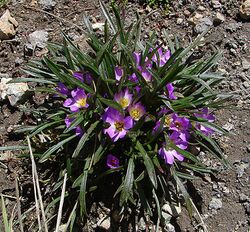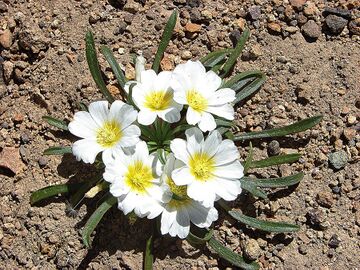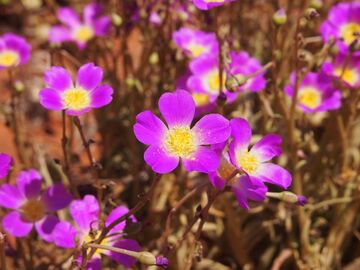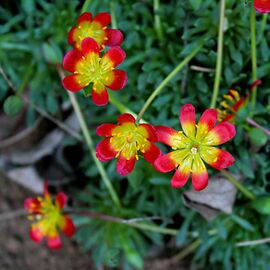Biology:Calandrinia
| Calandrinia | |
|---|---|

| |
| Calandrinia colchaguensis | |
| Scientific classification | |
| Kingdom: | Plantae |
| Clade: | Tracheophytes |
| Clade: | Angiosperms |
| Clade: | Eudicots |
| Order: | Caryophyllales |
| Family: | Montiaceae |
| Genus: | Calandrinia Kunth |
| Synonyms[1] | |
| |
Calandrinia is a large genus of flowering plants known as purslanes and redmaids. It includes over 100 species of annual and perennial herbs which bear colorful flowers in shades of red to purple and white. Plants of this genus are native to Australia, western South America, Central America, and western North America. Some species have been introduced to parts of New Zealand, southern Africa, Asia, and Europe.[1]
Description
Species in the genus Calandrinia are annual or perennial herbaceous plants with a sprawling or erect habit. The leaves are mostly basal and may be either alternate or opposite in arrangement. Flowers are produced in cymes. Each flower produces between four and eleven petals, though often five. Flowers may be white, purple, pink, red, or yellow.[2][3][4]
Taxonomy
The genus Calandrinia was erected in 1823 by German botanist Carl Sigismund Kunth.[5][6] It was named for Jean Louis Calandrini (1703–1758), a Genevan botanist.[3]
Approximately 74 Calandrinia species are native to Australia.[7] Along with the pigweeds (Portulaca species), Calandrinia are the most prominent succulent species in Australia.[8] The Australian Calandrinia were traditionally considered to be monophyletic (share the same ancestry) with 14 Calandrinia species from the Americas, and are still classified as belonging to the same genus.[9] However, in 1987 Australian taxonomist Roger Carolin proposed that the American and Australian Calandrinia are not closely related to each other based on morphological analyses. Follow-up studies also supported two different lineages, based in part on the absence of Calandrinia on islands along possible dispersal pathways between South America and Australia and in part on genomic data.[10][7]
Despite this, the nomenclature has not been officially changed for all Australian Calandrinia, including C. balonensis. Although the need for a nomenclature change is widely agreed, a debate has arisen over the appropriate naming of the Australian Calandrinia.[11] A proposal has been made to rename the genus as Parakeelya on the grounds that it is used as a common name for the whole genus, derives from South Australian and Central Desert Indigenous names, and is already accepted as a synonym for some Australian species.[12] The competing view holds that the Australian genus should be named Rumicastrum according to established nomenclatural rules.[11] Plants of the World Online accepts Rumicastrum.[13] The proposal to rename Calandrinia as Parakeelya has not yet been decided.[9]
The genus is classified in the family Montiaceae.[1] It was previously placed in the purslane family, Portulacaceae.[3]
Species
(As of November 2023), accepted species in Kew's Plants of the World Online include:[1]
Formerly placed here
The following species were formerly placed in genus Calandrinia, including the Australasian species now placed in genus Rumicastrum.[1][11]
- Anacampseros australiana J.M.Black (as C. pogonophora F.Muell.)
- Cistanthe arenaria (Cham.) Carolin ex Hershk. (as C. arenaria Cham. or C. glaucopurpurea Reiche)
- Cistanthe crassifolia (Phil.) Carolin ex Hershk. (as C. crassifolia Phil.)
- Cistanthe densiflora (Barnéoud) Hershk. (as C. densiflora Barnéoud or C. spicata Phil.)
- Cistanthe grandiflora (Lindl.) Schltdl. (as C. grandiflora Lindl. or C. spectabilis Otto & A.Dietr.)
- Cistanthe litoralis (Phil.) Carolin ex Hershk. (as C. litoralis Phil.)
- Cistanthe mucronulata (Meyen) Carolin ex Hershk. (as C. mucronata Meyen)
- Cistanthe picta (Gillies ex Arn.) Carolin ex Hershk. (as C. picta Gillies ex Arn. or C. villanuevae Phil.)
- Cistanthe sitiens (I.M.Johnst.) J.M.Watson & A.R.Flores (as C. sitiens I.M.Johnst.)
- Montiopsis andicola (Gillies) D.I.Ford (as C. andicola Gillies or C. tricolor Phil.)
- Montiopsis conferta (Gillies ex Arn.) Peralta (as C. conferta Gillies ex Arn., C. caesia F.Phil. ex Phil., or C. hirtella Phil.)
- Montiopsis gayana (Barnéoud) D.I.Ford (as C. calycotricha Phil.)
- Montiopsis gilliesii (Hook. & Arn.) D.I.Ford (as C. gilliesii Hook. & Arn. or C. leucotricha Phil.)
- Montiopsis potentilloides (Barnéoud) D.I.Ford (as C. potentilloides Barnéoud or C. setosa Phil.)
- Rumicastrum arenicolum (Syeda) Hershk. (as C. arenicola Syeda)
- Rumicastrum baccatum (Obbens) Hershk. (as C. baccata Obbens)
- Rumicastrum balonense (Lindl.) Carolin – broadleaf parakeelya (as C. balonensis Lindl.)
- Rumicastrum brevipedatum (F. Muell.) Carolin (as C. brevipedata F.Muell.)
- Rumicastrum butcherense (Obbens) Hershk. (as C. butcherense Obbens)
- Rumicastrum calyptratum (Hook. f.) Carolin – pink purslane (as C. calyptratum Hook.f.)
- Rumicastrum compositum (Nees) Carolin (as C. composita (Nees) Benth.)
- Rumicastrum corrigioloides (F. Muell. ex Benth.) Carolin – strap purslane (as C. corrigioloides F.Muell. ex Benth.)
- Rumicastrum creethae (Tratman ex Morrison) Carolin (as C. creethae Tratman ex Morrison)
- Rumicastrum crispisepalum (Obbens) Hershk. (as C. crispipetala Obbens)
- Rumicastrum cygnorum (Diels) Carolin (as C. cygnorum Diels)
- Rumicastrum cylindricum (Poelln.) Carolin (as C. cylindrica Poelln.)
- Rumicastrum dielsii (Poelln.) Carolin (as C. dielsii Poelln.)
- Rumicastrum dipetalum (J.M.Black) Carolin (as C. dipetala J.M.Black)
- Rumicastrum dispermum (J.M.Black) Carolin (as C. disperma J.M.Black)
- Rumicastrum eremaeum (Ewart) Carolin – twining purslane (as C. eremaea Ewart)
- Rumicastrum flavum (Obbens) Hershk. (as C. flava Obbens)
- Rumicastrum gracile (Benth.) Carolin (as C. gracilis Benth.)
- Rumicastrum granuliferum (Benth.) Carolin – pygmy purslane (as C. granulifera Benth.)
- Rumicastrum holtumii (Obbens & L.P.Hancock) Hershk. (as C. holtumii Obbens & L.P.Hancock)
- Rumicastrum hortiorum (Obbens) Hershk. (as C. hortiurum Obbens}
- Rumicastrum kalanniense (Obbens) Hershk. (as C. kalanniensis Obbens)
- Rumicastrum liniflorum (Fenzl) Carolin (as C. liniflora Fenzl)
- Rumicastrum maryonii (S. Moore) Carolin (as C. maryonii S.Moore)
- Rumicastrum mirabile (Chinnock & J.G.West) Hershk. (as C. mirabilis Chinnock & J.G.West)
- Rumicastrum monogynum (Poelln.) Carolin (as C. monogyne Poelln.)
- Rumicastrum monospermum (Syeda ex Obbens) Hershk. (as C. monosperma Syeda ex Obbens)
- Rumicastrum morrisae (Goy) Carolin (as C. morrisae Goy)
- Rumicastrum oblongum (Syeda & Carolin) Hershk. (as C. oblonga Syeda & Carolin)
- Rumicastrum opertum (Obbens)Hershk. (as C. operta Obbens)
- Rumicastrum orarium (Obbens) Hershk. (as C. oraria Obbens)
- Rumicastrum papillatum (Syeda) Carolin (as C. papillata Syeda)
- Rumicastrum pentavalvis (Obbens) Hershk. (as C.pentavalve Obbens)
- Rumicastrum pickeringii (A. Gray) Carolin (as C. pickeringii A.Gray
- Rumicastrum pleiopetalum (F.Muell.) Carolin (as C. pleiopetala F.Muell.)
- Rumicastrum polyandrum (Benth.) Carolin (as C. polyandra Benth.)
- Rumicastrum polypetalum (Fenzl) Carolin (as C. polypetala Fenzl)
- Rumicastrum poriferum (Syeda) Carolin (as C. porifera Syeda)
- Rumicastrum primuliflorum (Diels) Carolin (as C. primuliflora Diels)
- Rumicastrum ptychospermum (F. Muell.) Carolin (as C. ptychosperma F.Muell.)
- Rumicastrum pumilum (Benth.) Carolin (as C. pumila (Benth.) F.Muell.
- Rumicastrum quadrivalve (F.Muell.) Carolin (as C. quadrivalvis F.Muell.)
- Rumicastrum quartziticum (Obbens) Hershk. (as C. quartzitica Obbens)
- Rumicastrum remotum (J.M.Black) Carolin (as C. remota J.M.Black)
- Rumicastrum reticulatum (Syeda) Carolin (as C. reticulata Syeda)
- Rumicastrum rubrisabulosum (Obbens) Hershk. (as C. rubrisabulosa Obbens)
- Rumicastrum schistorhizum (Morrison) Carolin (as C. schistorhiza Morrison)
- Rumicastrum sculptum (Obbens) Hershk. (as C. sculpta Obbens & J.G.West)
- Rumicastrum spergularinum (F.Muell.) Carolin (as C. spergularina F.Muell.)
- Rumicastrum sphaerophyllum (J.M.Black) Carolin (as C. sphaerophylla J.M.Black)
- Rumicastrum stagnense (J.M.Black) Carolin (as C. stagnensis J.M.Black)
- Rumicastrum stenogynum (Domin) Carolin (as C. stenogyna Domin)
- Rumicastrum strophiolatum (F.Muell.) Carolin (as C. strophiolata (F.Muell.) F.Muell. ex B.D.Jacks.)
- Rumicastrum tepperianum (W.Fitzg.) Carolin (as C. tepperiana W.Fitzg.)
- Rumicastrum tholiforme (Obbens) Hershk. (as C. tholiformis Obbens)
- Rumicastrum translucens (Obbens) Hershk. (as C.translucens Obbens)
- Rumicastrum tumidum (Syeda) Hershk. (as C. tumida Syeda)
- Rumicastrum umbelliforme (Obbens) Hershk. (as C. umbelliformis Obbens)
- Rumicastrum uniflorum (F. Muell.) Carolin (as C. uniflore F.Muell.)
- Rumicastrum vernicosum (Obbens) Hershk. (as C. vernicosa Obbens)
- Rumicastrum volubile (Benth.) Carolin (as C. volubilis Benth.)
- Rumicastrum wilsonii (Obbens) Hershk. (as C. wilsonii Obbens)
Uses
Calandrinia balonensis is recorded in the 1889 book The Useful Native Plants of Australia as being called "periculia" by Indigenous Australians and that the plant was eaten by Europeans with bread while Indigenous Australians used it as a food when mixed with baked bark. "The seed is used for making a kind of bread, after the manner of that of Portulaca oleracea. (Mueller, Fragm., x., 71.)."[14]
References
- ↑ 1.0 1.1 1.2 1.3 1.4 "Calandrinia Kunth". Royal Botanical Gardens Kew. https://powo.science.kew.org/taxon/urn:lsid:ipni.org:names:331443-2.
- ↑ "Calandrinia". VicFlora, Royal Botanic Gardens Victoria. https://vicflora.rbg.vic.gov.au/flora/taxon/4e082257-f0d1-45f6-a90b-b51e95393d66.
- ↑ 3.0 3.1 3.2 Kelley, Walter A. (2003), "Calandrinia", in Flora of North America Editorial Committee, Flora of North America North of Mexico (FNA), 4, New York and Oxford, http://www.efloras.org/florataxon.aspx?flora_id=1&taxon_id=105022, retrieved 11 January 2019
- ↑ Elvebakk, Arve; Flores, Ana Rosa; Watson, John Michael (19 March 2015). "Revisions in the South American Calandrinia caespitosa complex (Montiaceae)". Phytotaxa 203 (1): 1. doi:10.11646/phytotaxa.203.1.1.
- ↑ Kunth in Humb., Bonpl. & Kunth, Nov. Gen. et Sp. vi. 1823. Page 77. Illustration.
- ↑ "Calandrinia Kunth". International Plant Names Index. http://beta.ipni.org/n/331443-2.
- ↑ 7.0 7.1 Hancock, L.P, Obbens, F., Moore, A.J., Thiele, K., de Vos, J.M, West, J., and Edwards, E.J. (2018). "Phylogeny, evolution, and biogeographic history of Calandrinia (Montiaceae)". American Journal of Botany 105 (6): 1021–1034. doi:10.1002/ajb2.1110. PMID 29995314.
- ↑ Low, T. (2016). "Where are all the succulents?". Wildlife Australia 53: 12–14.
- ↑ 9.0 9.1 Thiele, Kevin (2018-12-29). "On the Horizon: Calandrinia changing to Parakeelya" (in en). https://www.taxonomyaustralia.org.au/post/taxonomy-alert-calandrinia-changing-to-parakeelya.
- ↑ Tahir, S.S. and Carolin, R.C. (1990). "Phylogeny and origin of Australian Calandrinia (Portulacaceae)". Pakistan Journal of Botany 22: 1–4.
- ↑ 11.0 11.1 11.2 Hershkovitz, M.A. (2020). "Rumicastrum Ulbrich (Montiaceae): a beautiful name for the Australian calandrinias". Phytologia 102: 116–123.
- ↑ Thiele, K.R., Obbens, L., Hancock, E., Edwards, E. and West, J.G. (2018). "Proposal to conserve the name Parakeelya against Rumicastrum". Taxon 67: 214–215. doi:10.12705/671.25.
- ↑ Rumicastrum Ulbr. Plants of the World Online. Accessed 17 November 2023.
- ↑ J. H. Maiden (1889). The useful native plants of Australia : Including Tasmania. Turner and Henderson, Sydney. https://primo-slnsw.hosted.exlibrisgroup.com/primo-explore/fulldisplay?docid=SLNSW_ALMA21105097830002626&context=L&vid=SLNSW&search_scope=EEA&tab=default_tab&lang=en_US.
Wikidata ☰ Q629492 entry
 |






